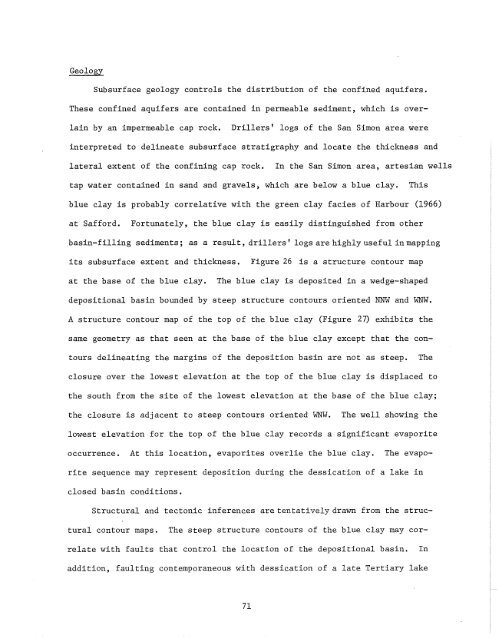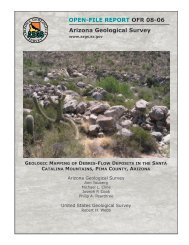geothermal resource potential of the safford-san simon basin, arizona
geothermal resource potential of the safford-san simon basin, arizona
geothermal resource potential of the safford-san simon basin, arizona
Create successful ePaper yourself
Turn your PDF publications into a flip-book with our unique Google optimized e-Paper software.
Geology<br />
Subsurface geology controls <strong>the</strong> distribution <strong>of</strong> <strong>the</strong> confined aquifers.<br />
These confined aquifers are contained in permeable sediment, which is overlain<br />
by an impermeable cap rock.<br />
Drillers' logs <strong>of</strong> <strong>the</strong> San Simon area were<br />
interpreted to delineate subsurface stratigraphy and locate <strong>the</strong> thickness and<br />
lateral extent <strong>of</strong> <strong>the</strong> confining cap rock.<br />
In <strong>the</strong> San Simon area, artesian wells<br />
tap water contained in <strong>san</strong>d and gravels, which are below a blue clay.<br />
This<br />
blue clay is probably correlative with <strong>the</strong> green clay facies <strong>of</strong> Harbour (1966)<br />
at Safford.<br />
Fortunately, <strong>the</strong> blue clay is easily distinguished from o<strong>the</strong>r<br />
<strong>basin</strong>-filling sediments; as a result, drillers' logs are highly useful in mapping<br />
its subsurface extent and thickness. Figure 26 is a structure contour map<br />
at <strong>the</strong> base <strong>of</strong> <strong>the</strong> blue clay.<br />
The blue clay is deposited in a wedge-shaped<br />
depositional <strong>basin</strong> bounded by steep structure contours oriented NNW<br />
and WNW.<br />
A structure contour map <strong>of</strong> <strong>the</strong> top <strong>of</strong> <strong>the</strong> blue clay (Figure Zn exhibits <strong>the</strong><br />
same geometry as that seen at <strong>the</strong> base <strong>of</strong> <strong>the</strong> blue clay except that <strong>the</strong> contours<br />
delineating <strong>the</strong> margins <strong>of</strong> <strong>the</strong> deposition <strong>basin</strong> are not as steep.<br />
The<br />
closure over <strong>the</strong> lowest elevation at <strong>the</strong> top <strong>of</strong> <strong>the</strong> blue clay is displaced to<br />
<strong>the</strong> south from <strong>the</strong> site <strong>of</strong> <strong>the</strong> lowest elevation at <strong>the</strong> base <strong>of</strong> <strong>the</strong> blue clay;<br />
<strong>the</strong> closure is adjacent to steep contours oriented WNW.<br />
The well showing <strong>the</strong><br />
lowest elevation for <strong>the</strong> top <strong>of</strong> <strong>the</strong> blue clay records a significant evaporite<br />
occurrence. At this location, evaporites overlie <strong>the</strong> blue clay. The evaporite<br />
sequence may represent deposition during <strong>the</strong> dessication <strong>of</strong> a lake in<br />
closed <strong>basin</strong> conditions.<br />
Structural and tectonic inferences are tentatively drawn from <strong>the</strong> structural<br />
contour maps.<br />
The steep structure contours <strong>of</strong> <strong>the</strong> blue clay may correlate<br />
with faults that control <strong>the</strong> location <strong>of</strong> <strong>the</strong> depositional <strong>basin</strong>.<br />
In<br />
addition, faulting contemporaneous with dessication <strong>of</strong> a late Tertiary lake<br />
71

















